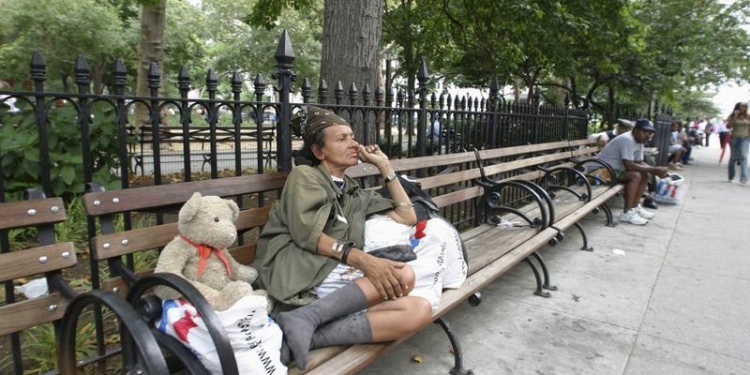April 1, 2025 – New York City’s homelessness crisis has reached unprecedented levels, with shelters bursting at the seams and thousands sleeping on the streets. As of January 2025, 120,513 people slept in city shelters nightly, a figure driven by both long-term residents and a surge of migrants, according to the Coalition for the Homeless. The city’s unique “right to shelter” mandate, in place since 1981, legally obligates it to house anyone in need, but this system is under severe strain, exacerbated by illegal immigration. Below, we explore the scope of the crisis, analyze the impact of undocumented migrants, and present officials’ statements on potential resolutions.
The Scale of Homelessness in New York
New York’s homeless population has soared to its highest since the Great Depression, with 70% of shelter residents being families, including 41,615 children, per the Coalition for the Homeless. Over 146,000 schoolchildren experienced homelessness in the 2023-2024 school year—one in eight city students. The primary driver is a lack of affordable housing, with 1.1 million affordable units lost between 1996 and 2017 and a vacancy rate below 1% for low-cost apartments. However, the influx of migrants has intensified this pressure, doubling the shelter population from 50,000 to over 120,000 in two years, as reported by The New York Times.
Impact of Illegal Immigration
Since spring 2022, over 210,000 migrants have arrived in NYC, many crossing the U.S.-Mexico border illegally, according to The New York Times. Of the 120,513 shelter residents in January 2025, 46,418—or 39%—were “New Arrivals,” a term often encompassing undocumented immigrants. This influx, partly fueled by southern governors busing migrants to northern cities, has overwhelmed the shelter system, which now houses about 64,000 migrants, per FAIRUS.org. The city’s right-to-shelter policy, originally designed for local homeless individuals, has been stretched to accommodate these newcomers, costing an estimated $10 billion over three years, as stated by Mayor Eric Adams.
The competition for shelter space has sparked tensions. Posts on X, like one from @Sala2arrr on March 30, claim “illegals grab shelter spots that NYers could’ve gotten—forcing them outside,” reflecting a sentiment that migrants displace local residents. While not all migrants are undocumented, the lack of legal work authorization—delays for permits can stretch years—keeps many reliant on shelters, draining resources. Critics, including Newsweek, argue this prioritizes foreigners over citizens, noting 40,000 homeless veterans and a disproportionate Black homeless population (40%) sidelined amid the crisis.
Official Statements and Proposed Resolutions
New York officials have voiced frustration and offered varied solutions. Mayor Adams, speaking on August 9, 2023, said, “New Yorkers did not create an international humanitarian crisis, but we’ve been left to deal with it almost entirely on our own… We need additional resources.” On X on March 31, 2025, he pushed for fiscal relief: “Our ‘Axe the Tax’ proposal is another step closer to helping hundreds of thousands of working-class New Yorkers save more of their hard-earned money!”—suggesting budget reallocations to ease pressure on social services.
In recent years, homelessness in New York City has reached the highest level since the Great Depression of the 1930s.
- In January 2025, 120,513 people slept each night in NYC shelters. Thousands more (there is no reliable number, as the annual HOPE estimate is deeply flawed) slept unsheltered in public spaces, and more than 200,000 people slept temporarily doubled-up in the homes of others. Thus, it can be estimated that more than 350,000 people were without homes in NYC in January 2025.
- In January 2025, 70 percent of those in shelters were members of homeless families, including 41,615 children. That month, 35,651 single adults slept in shelters. Thirty-nine percent of those in shelters, or 46,418 individuals, were New Arrivals.*
- More than 146,000 NYC schoolchildren experienced homelessness at some point during the 2023–2024 school year, representing one in eight children attending city schools.
- The primary reason people in NYC become homeless is the lack of affordable housing. Surveys of homeless families have identified the following major immediate, triggering causes of homelessness in NYC: eviction; doubled-up or severely overcrowded housing; domestic violence; job loss; and hazardous housing conditions.
- Between 1996 and 2017, NYC lost 1.1 million units of affordable housing. The most recent Housing Vacancy Survey indicates a vacancy rate of less than one percent for affordable apartments in NYC.
- Families entering shelters (excluding New Arrivals) predominantly come from a few clustered zip codes in the poorest neighborhoods in NYC. However, every community district in NYC contributes to the ongoing homelessness crisis.
- Compared to homeless families, homeless single adults have higher rates of serious mental illness, substance use disorders, and other severe health problems. There is not yet reliable data on such rates New Arrivals in the shelter system.
- Of the longer-term New Yorkers (non-New Arrivals) sleeping in the DHS shelters, 43 percent of families with children, 65 percent of single adults, and 75 percent of families without minor children have a disability requiring a facility-related accommodation.
- The majority of unsheltered homeless individuals are people living with a mental illness or other severe health problems.
- Black and Hispanic/Latinx New Yorkers are disproportionately affected by homelessness. Approximately 56 percent of heads of household in shelters are Black, 32 percent are Hispanic/Latinx, 7 percent are White, less than 1 percent are Asian-American or Native American, and 4 percent are of unknown race/ethnicity. Demographic info on asylum seekers and other new arrivals in shelters has not been provided by the City.
- In City Fiscal Year 2023, the average length of stay in the DHS shelter system was 412 days for single adults, 437 days for families with children, and 750 days for adult families.
- New York’s legal Right to Shelter has given more than one million homeless New Yorkers a way off the streets since 1981.






























Discussion about this post